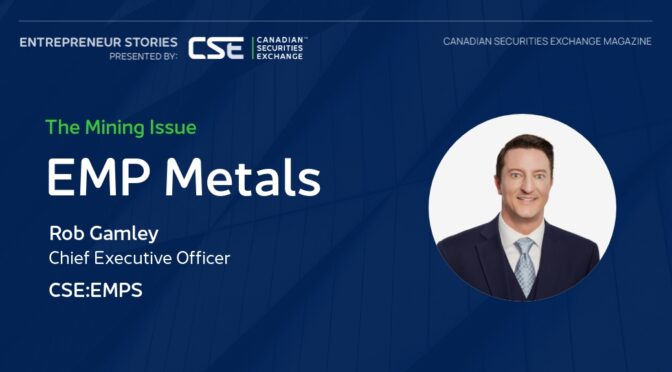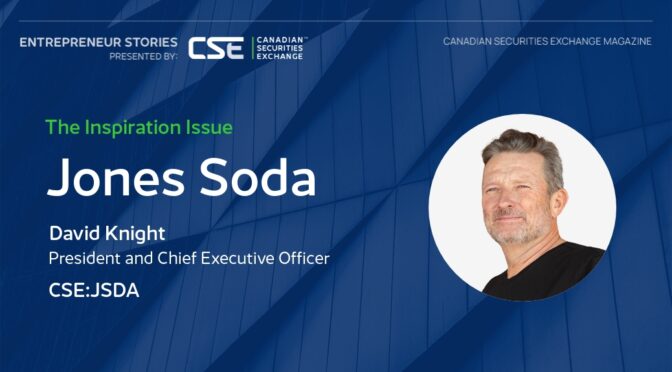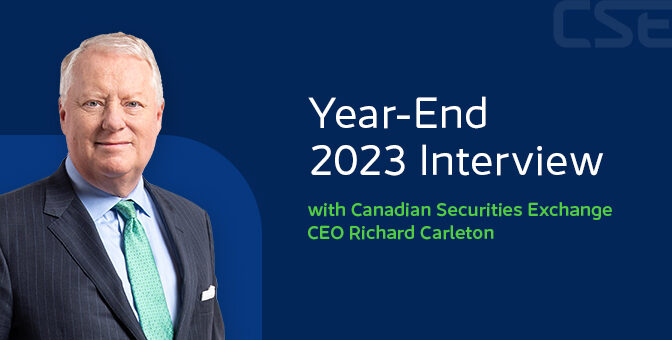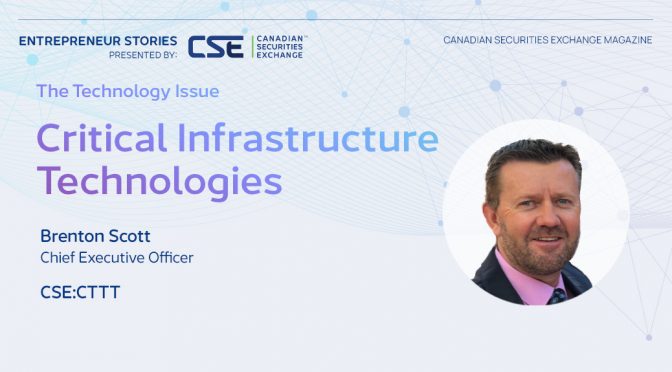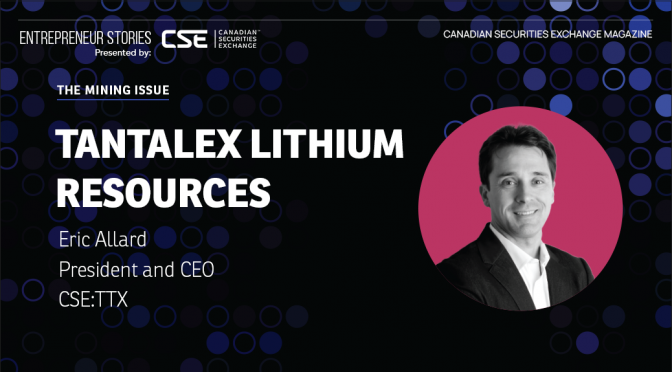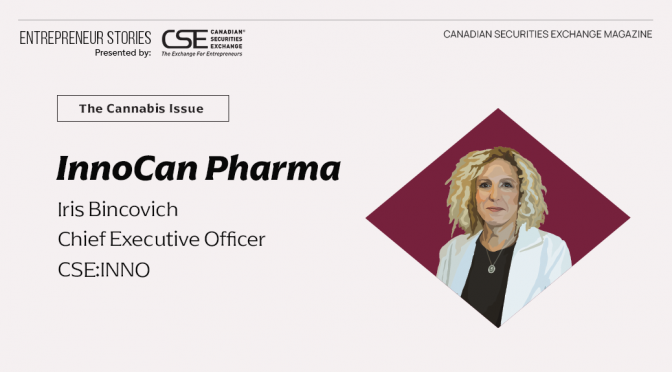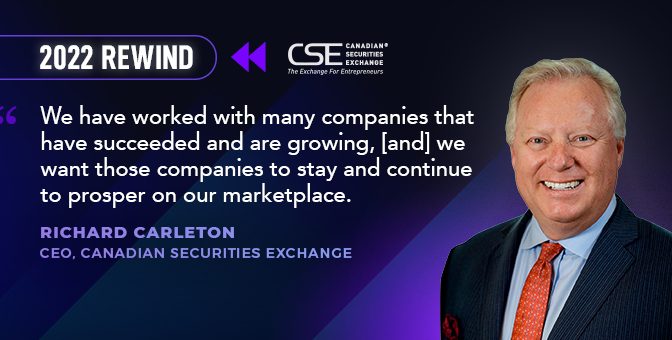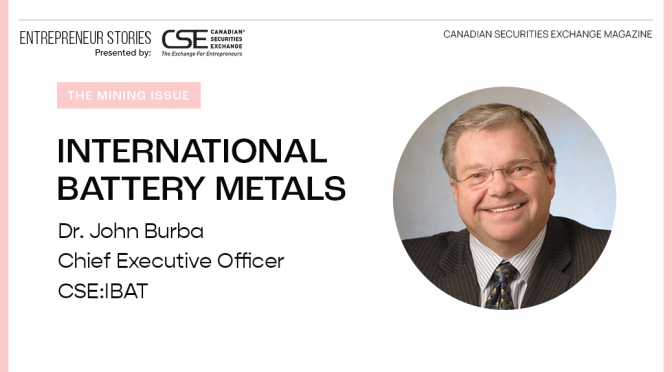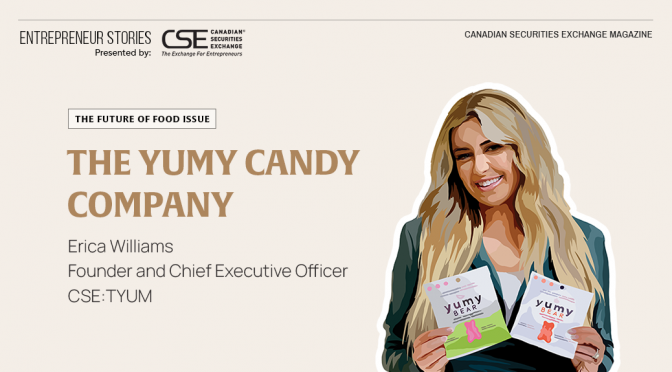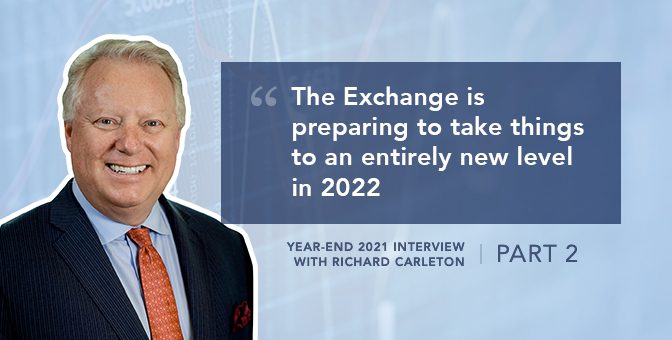With 2022 drawing to a close, the global financial community is looking back on yet another year of unprecedented activity across markets. Governments relaxed pandemic restrictions and wound down historic financial support for individuals and companies, just as interest rates surged in response to inflation concerns that proved to be highly warranted. Shifts in the geopolitical and security landscapes added to the uncertainty.
As always, volatility means difficult times for some and opportunity for others. The mining industry was in the spotlight to be sure, as prices for some metals weakened modestly, while others rose or remained strong. Cannabis rode expectations for regulatory change in the US to both the upside and downside.
The Canadian Securities Exchange took this environment in stride, leveraging competitive advantages that have underpinned its success by making it a popular listing destination for entrepreneurial companies from around the world. The year 2023 looks set to be transformational for the CSE, with several major developments on the horizon that are important for investors, issuers and the financial professionals who serve them to know about.
Canadian Securities Exchange CEO Richard Carleton sat down recently to discuss key accomplishments during 2022 and their meaning for the CSE, as well as to explore some of the changes on deck for 2023.
We have a number of important topics to cover, including some substantial developments set to take place at the CSE early in the new year. But before getting to these, it’s important to set the table with some thoughts on financial markets in 2022. Markets seemed more challenging to figure out than usual. What is the view at the CSE?
Well, I guess there are a few themes. The first is that mining is really driving the bus in terms of capital raised and generating the vast majority of our new listings. And different from some past mining cycles we have seen at the Canadian Securities Exchange, there is investor interest across a range of metals.
Rather than the traditional emphasis on precious metals exploration, we have seen a focus on battery metals: nickel, copper, zinc, cobalt, as well as lithium, graphite and rare earths.
Many of these companies are exploring sites where historic drilling took place. World prices for those metals could not support or commercialization of these deposits some years ago. I think it’s fair to say that given the increases in commodity prices, particularly when we consider them in Canadian dollars, the likelihood of producing mines being developed on these properties is higher than perhaps we have seen in earlier mining cycles.
On the other hand, we are seeing lower levels of trading activity on the exchange. Far fewer people working from home at this point, and I think the increase in interest rates has put a lot of investors in defensive mode, particularly retail investors. The decline in major indices, especially those tracking large technology companies, has also made people somewhat more conservative in terms of risk profile in my view.
The amount of money raised by companies on the exchange is also smaller than we have seen for the last few years. This can be explained by the fact that early-stage mining exploration companies are coming to market with relatively modest market capitalizations; they don’t need a lot of money to fund the initial phases of drilling they are looking to carry out. This contrasts with the large, integrated US cannabis companies coming to market a few years ago where single companies were raising several hundred million dollars in one go.
Overall, financing activity is robust, but it is not accounting for anywhere near the total sums of money that we saw in the latter part of 2020 and early part of 2021.
The CSE continues to pursue issuers from jurisdictions outside of Canada: Australia, Israel and the US are prime examples. Why these markets in particular and what are the plans for 2023?
I believe that one of the best things that Canada does as an economy is to provide public venture capital to early-stage companies. When we are looking at applying the services and skills we offer, we view, in particular, Israel, Australia and the United States as three dynamic places that support start-up companies. But in Israel and the United States, there isn’t a marketplace like the CSE that services early-stage companies with the focus that we bring to the table.
In the case of Australia, we have real interest from the mining community, especially with mining very much back on the minds of investors in North America. We can help Australian companies, that have maybe raised their preliminary capital in Australia, to access more of the global markets through a listing on the Canadian Securities Exchange. This makes them more accessible to investors in Canada, the United States and Europe. What we are looking for are dynamic economies generating lots of start-up companies, but where the companies are perhaps underserved by local markets in their effort to raise public capital.
The CSE has been working on a blockchain-based system for the clearing and settlement of tokenized securities. Where does the project stand and have recent developments outside the Exchange influenced your strategy?
We’ve made good progress on the technology. In fact, this summer we tested the full cycle of a trade with one of the dealers. That would be the trade, through clearing and settlement to all of the back-office processes that need to be completed in order to finalize a transaction. From that perspective, we have continued to make good progress.
It is fair to say that the crypto winter, or whatever you might call it, has influenced how we are thinking about this effort as we move forward. We have a lot of very credible people who are looking to tokenize securities to take advantage of some of the strengths of the technology, and we are continuing to work with regulators on a framework for that.
I think regulators will be conservative in their approach to tokenized securities in view of the situation with FTX and the knock-on impact on a number of participants in the crypto space. None of these, to be honest, are all that relevant to the traditional securities world, which is what we occupy. But, as I say, I believe it will make the regulators more conservative in terms of their approach with regard to thinking about some of the things that we are looking to achieve.
There are a number of job postings on the CSE website, mostly in customer support and regulation. What specific needs will the exchange be addressing with these hires?
A lot of the growth is taking place in our Vancouver office, and it is very much tied to the changes we are looking to implement in our listings policies. We have been working with the regulators and believe we are very close to coming to terms with the British Columbia Securities Commission and the Ontario Securities Commission on the approval of these policies.
The commissions are asking us to take on a larger role in overseeing a number of aspects regarding issuers listed on the exchange. For example, we will be launching a senior tier, which perhaps 80 to 100 companies will qualify for.
The way the regulations work, and exchange policies, is that these companies will be subject to closer scrutiny than the more junior companies. That is more labour intensive from the exchange’s perspective, and we have been staffing up to meet the obligations we are undertaking as a result of these policy changes.
The CSE team participated in several cannabis industry events in 2022, and you were recently named “Capital Markets Advocate of the Year” by the American Trade Association for Cannabis and Hemp. What is the exchange’s motivation to devote so many resources to the cannabis industry? And what have you learnt about the cannabis industry that the market doesn’t know but needs to?
I think roughly 85% of the market capitalization on the exchange is in the cannabis space. They are our largest companies, our most mature companies, and they account for the vast majority of the revenues generated by companies on the CSE. So, it is a very important community for us to work with and to recognize and support.
There are also a significant number of private companies in the United States in the cannabis sector who don’t like the asset values being given in the public markets right now, especially in light of the decline in share price for many of the companies after Senator McConnell indicated that he was not going to support the SAFE Banking Act, which is liberalization of the rules around access to banking services for the cannabis industry. He suggested he would not be backing that during this session of Congress, and perhaps beyond.
In any event, there is a significant additional number of companies in the United States that we believe will be candidates for listing at some point, so we are trying to keep those relationships warm, even though valuations are not as attractive at the moment as they once were.
I will focus on some of the challenges the US cannabis industry faces in the capital markets. It is unique in the sense that, particularly for the US companies, about 97% of the shares are held by retail accounts. For a number of reasons, there is very little institutional participation in these names. For some it is because they are not listed on a national securities exchange in the United States, because their custodian refuses to keep shares of US cannabis companies in custody, because of volatility, or because they are operating in a state where cannabis is illegal. Many institutions have determined that it is not an investment they are prepared to make.
What that means is that there just isn’t the kind of long-term institutional holding of these shares, which I think has made them considerably more volatile, both up and down, than some of the other companies in their consumer-packaged goods peer group.
When people look at these big price swings, it is important to understand that this is not a Procter & Gamble or something along those lines, where you have a significant percentage of the stock held by institutions, fund managers or ETFs. This is all pretty much retail activity, and retail investors may not have the patience, investment horizon or approach that you would see from an institution. That’s fine, but people need to understand that the profile of these companies may be a little different when it comes to secondary market trading activity as a result.
Mining is another sector that is historically important to the CSE. In 2022, over 70 new mining companies have listed on the exchange. What makes the CSE such a good home for resource companies?
There are two things that I would highlight. The first one is that our team has a really good reputation with leaders in the entrepreneurial community, as well as the investment bankers and the accountants and the lawyers who service that community. We have surveyed these groups over the course of the year to get a better understanding of how they see us and our competitors. We see not only a high level of satisfaction, but a lot of repeat business from these professionals who have had a positive experience as they bring a company to market on the Canadian Securities Exchange.
That experience includes everything from the analysts reviewing files to our accountants. As one example, Francis Manns is an experienced consulting geologist who was extremely influential in the development of 43-101 reports for mining. He is now a resource at the CSE available to our issuers as they look to improve the quality of their public disclosure through technical documentation. He is a highly regarded individual and someone whom people in the industry look forward to working with.
The other piece is that our pricing is very amenable and responsive to the needs of the mining community. It is less expensive to list on the Canadian Securities Exchange than on other markets via IPOs and RTOs. We have long had a policy of providing cost certainty for companies. We are not looking to charge fees as a company raises money, for instance. We are not in the situation where we are nickel-and-diming our companies. They know at the start of the year what their budget is for maintaining a listing on the Canadian Securities Exchange and we stick to that. This is something the companies appreciate because they apply more of the money raised to advancing their projects, as opposed to putting it in the back pocket of the exchange where they happen to be listed.
I think the combination of those two things gives us a powerful leg up when it comes to attracting new business from the mining industry.
In October, the exchange launched the CSE2 trading venue. What exactly is CSE2 and what led you to launch a new venue in what appears to be a fairly crowded landscape?
This is a difficult question to answer quickly because it involves a grasp of evolving Canadian equity market structure. But I’ll give it a try.
An increasing number of brokers are providing zero-commission trading for their clients. People wonder how they get paid if they are not charging clients anything for the trading services they provide.
One of the ways is to monetize order flow from their clients. So, how do they do that?
Markets in Canada typically incent the provision of liquidity by providing a rebate to the party that posts an order that eventually trades. And they charge a higher fee to the party who accesses that liquidity by causing the trade to happen. It is known as “maker-taker” because one party makes the liquidity and the other party takes it. The maker gets a rebate and the taker is charged a fee.
All markets now have a second book which has an inverted price method in which the party who takes the liquidity receives the rebate and the party who posts the order is charged a fee. That way, the discount broker, let’s say, receives a rebate when they post a non-marketable order, and they receive a rebate in the inverted market when they trade against an order that is already there. That way they get rebates on their active orders and they get rebates on their passive orders.
Now, remember how important retail is to the Canadian Securities Exchange, and a lot of that order flow is coming from discount brokers that have reduced or eliminated trading charges over the last few years.
It is thus critical for us, if we are to maintain our price discovery role in the marketplace, to ensure that we continue to gather as many of the passive and active orders for companies listed on the CSE as we possibly we can. Yes, it is a crowded marketplace, but we are the listing exchange and we need to maintain that price discovery for determining the market value of securities at any given time. The alternative is to potentially lose that to marketplaces that are not having to absorb the expenses and regulatory responsibility to actually list the company. That is where we are coming from with CSE2.
One of the biggest developments slated for 2023 is the introduction of a CSE senior tier. How will this differentiate the exchange and what other activities are you planning to support this evolution?
There are really a few things, but I guess the first misconception I want to clear up is that this involves us somehow declaring war on other exchanges in Canada and making a pitch to a company like Royal Bank to delist from the Toronto Stock Exchange and come over to the CSE. It really isn’t that at all.
We have a number of companies on the CSE that would meet the admission criteria on senior exchanges in Canada. And we don’t want to be in a position where those companies are able to follow lesser standards of corporate governance, or longer periods to provide quarterly reporting to the marketplace as well as their annual audit results by virtue of the fact that they are listed on the CSE.
We are trying to put those companies on a level playing field with their peers that are listed on the other senior markets in Canada. We also, obviously, want to retain these companies. I sometimes speak about the Nasdaq back in the 1970s and the 1980s as one of our inspirations. They did such a good job working with Microsoft and Cisco and Oracle way back when they didn’t qualify for the New York Stock Exchange because they lacked tangible assets in the form of factories and steel mills and those sorts of things. All they had was intellectual property and engineers working to improve it.
When the New York Stock Exchange tried to attract Bill Gates and the rest of the senior leadership of the young tech companies in the United States, they told them they were not going to move because they’d had such a positive experience working with Nasdaq as public companies.
That’s the kind of approach we would like to take. We have worked with many companies that have succeeded and are growing. We want those companies to stay and continue to prosper on our marketplace and not go somewhere else simply because they qualify.
The other part is that we are interested in the opportunity to list ETFs and structured products. Looking at some of the other markets in Canada, they have robust structured product and ETF offerings that attract a lot of new listing activity. That is something that has not been available to us in years past, and we hope to open that capability and compete on a level playing field with other exchanges in Canada for that business. We think there are a number of products, such as a true cannabis ETF, that really do have a natural home on the Canadian Securities Exchange.
Let’s close on a look back and a look ahead. Talk to us about what it took to build the CSE to its current status, and what amongst your team’s accomplishments makes you the proudest. What should the financial community expect from the CSE over the next two or three years?
I’m going to work backward and start with the question about what to expect. The answer is not all that exciting, but I’d say to anticipate more of the same. That means the CSE grows quickly and we continue to be responsive to the needs of the corporate finance community in Canada, and particularly to entrepreneurs. That way, whatever industry sectors are receiving support from the investor community in Canada, we will be here to support them and provide them with fair, transparent and accessible trading markets for their securities. And then overlay that with the opportunity to compete for more structured products and ETFs.
What did it take for us to get here? It is very much the team we built and the reputation it has earned through hard work and engagement with people across Canada, the United States and beyond. They achieve a very high level of customer satisfaction and repeat business – all of the indicators suggest that we will continue to be very competitive with our peers in bringing new companies to market, and really what it rests on is the people we have had around us for years. Our bench is deep and experienced. And we continue to add to it with people who are excited to join a group that did such a good job of building an exchange that is now a material part of the Canadian financial landscape.
There are not many other examples in the world of an alternative exchange like ours being successful and having the impact that it has had. I think that while all of us can take some pride in that, what we definitely can’t do now is to take it easy. It is still a very competitive landscape in Canada and beyond.

